Watch a Guillermo del Toro film, and chances are you’re watching a story about communication. Some of his stories are fairy tales, some are epics, some are horror, but they all revolve around this central theme—who gets to communicate, who doesn’t, how important it is, and what it costs when you’re denied that ability to connect with others. But The Shape of Water takes this theme farther than any of del Toro’s previous works. In fact, this homage to Creature From the Black Lagoon makes it clear that communication is a matter of life and death.
[Contain spoilers for The Shape of Water]
The particular oeuvre of Guillermo del Toro turns on many themes, but communication is often the spoke of his wheel. Pan’s Labyrinth is the story of a little girl whose inability to communicate her feelings amid worldly horrors leads to her retreating into a different realm. Crimson Peak revolves around a woman who works tirelessly to communicate with her husband when she realizes that he and his sister are withholding their past from her. Pacific Rim shows us what perfect communication might bring the world, from the jaegers that can save it to the pilots whose compatibility is realized in their cockpits. Even Hellboy and its sequel turn on these themes, focusing on Red’s difficulty communicating with Liz, and Abe Sapien’s trials in communicating with anyone at all. All of these people struggle to be heard and understood, to be seen as they communicate with others.
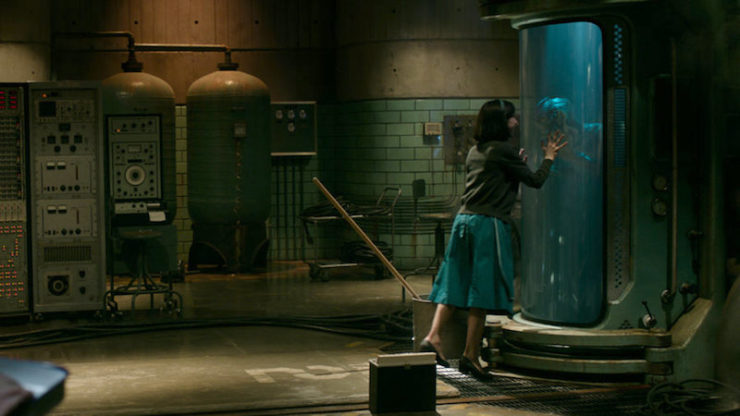
The Shape of Water concerns itself with the same themes, but takes them far deeper than any of its predecessors. And this is largely due to how the movie examines the ways that marginalized people carry out communication, and how it alters their relationship with the rest of the world. It centers on Elisa (Sally Hawkins), a mute woman living in the 1960s who works the night shift at the Occam Aerospace Research Center as a janitor. One day the center receives a water-dwelling being they refer to as the “Asset”, discovered in South America by Colonel Strickland (Michael Shannon). The U.S. intends to use the Asset in their fight against the Soviet Union by taking whatever they want from it (it is believed that the creature’s anatomy may be of use to space travel) and torturing it into compliance. Elisa forms a secret friendship with the Asset, and they soon fall in love. Once she realizes that the Colonel plans to dissect the man she loves, she asks a friend to help her smuggle him out of the facility. More friends join her cause along the way.
The fact that Elisa cannot speak means that when she wants people to understand her—as there are few around her who make any effort to learn sign language—others have to translate. Particularly two others: her friends Giles (Richard Jenkins) and Zelda (Octavia Spencer). This means that the people who speak for Elisa out in public and at her job are a closeted gay man and a black woman. Elisa’s ability to communicate with the majority of people in the world is filtered through two people who are in the perfect position to understand how difficult it is to communicate… because they are also prevented from communicating fully without penalty. Giles has very few people he can be honest with due to his sexuality, while Zelda has to take into account who she is speaking to in every situation to protect herself from sexism and more violent forms of bigotry due to her race.
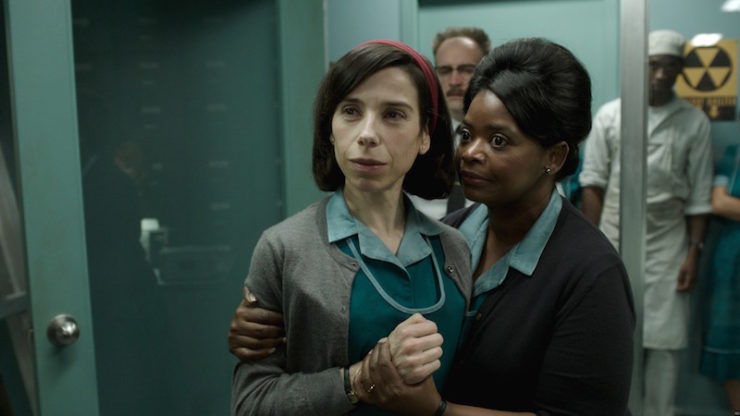
Through Elisa’s friends, the film examines what it means not to be able to communicate as one wishes due to societal pressures and dangers. Zelda gives certain coworkers a hard time when they don’t clean up their garbage (i.e. black coworkers, folks in the same class bracket, the people who she knows particularly well), but there are plenty of people at the Center who she has to step carefully around. Colonel Strickland makes that clear the moment he tears into their facility, insisting that the Asset is an abomination because only humans were made in God’s image. When Zelda admits that she has no idea what God might look like Strickland tells her that the Almighty looks like them… or perhaps more like him than her. And though Zelda had no trouble letting her other coworkers know what was what, she bites her tongue at the racist remark. She knows that talking back to Strickland is a dangerous idea, and she spends a great deal of time covering for Elisa to make certain that her friend is safe around him.
While Zelda has to deal with the intersectional identity of being black and also a woman, Giles has to deal with being a gay man who is also getting on in years. His age and old-fashioned way of working (his old advertising firm is moving on to photography while he still paints) result in his bosses refusing to give him his job back. His sexuality leads to his hesitance around others, including a young man working the counter at a local diner and pie shop. Giles, accustomed to hiding, initially refuses to help Elisa free the Asset, regardless of her emotional plea to him. The film acknowledges that the world is somewhat easier for Giles to navigate than Elisa and Zelda—unless he is more overt about his identity, he appears to be a straight white man to everyone around him. But after leaving a despairing Elisa, Giles heads back to the diner and decides to reach out to the young man behind the counter… and is abruptly shut down. Giles’s former crush kicks him out of the establishment shortly after telling a black couple that they’re not permitted inside either, something that Giles vocally objects to. In effect, the effort that Giles makes in finally communicating outwardly after so long results in a potent reminder that the world is a hostile place toward him. Following that, he agrees to help Elisa.
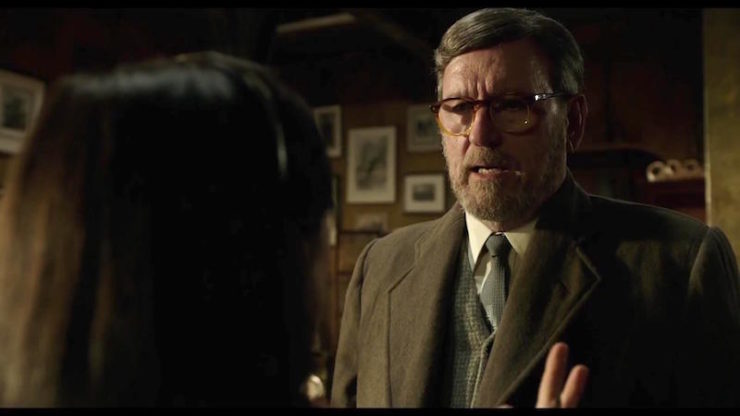
The surprise helper in Elisa’s plan to whisk away the Asset is Dr. Robert Hoffstetler—whose real name is Dmitri, a spy for the Soviet Union hidden among the Center’s staff. At first glance, his difficulty with communication seems obvious: as a double agent he must hide himself from the people he works with day to day, and his limited contact with his Soviet handler is the only time he is permitted to communicate openly. But in reality, Dmitri has a difficult time with both his Soviet contacts and Colonel Strickland because he is a scientist, first and foremost. As a scientist he does not agree with anyone’s plans regarding the Asset (Strickland wants it destroyed and dissected, the Russians are also willing to destroy it rather than risk an operation to steal it), and decides that Elisa is the only person fit to look after him. After helping the group and providing Elisa with a mixture that the Asset will need in his water, he confesses his true name to Zelda and Elisa. His only moment of true communication is when he is permitted to reveal his identity to two people who are capable of seeing him as an individual, and not a side in an ugly war.
Colonel Strickland himself is study in how people with power and privilege eschew communication and its benefits out of belief in their own superiority. Strickland has no interest in communicating with the Asset whatsoever—in fact, his only words to the creature are about how he hates the sound of its pained howling when he tortures it. The Colonel has no real interest in connecting with his family, barely speaking to his children and then telling his wife to be silent during sex because he has developed a fetish for Elisa’s muteness. When the Colonel wants to indicate his thoughts and beliefs he does it primarily through things like a good capitalist consumer: the cheap candy he eats and the expensive car he buys. After he loses the Asset, he refuses calls from the General Hoyt in order to maintain control of the situation, determined to fix everything before he has to talk to a superior. When he interviews Elisa and Zelda about the Asset’s disappearance, he eventually grows irritated with himself for bothering to question “the Help.” The only time he does bother to communicate with Elisa, it is to sexually harass her, and the only time he bothers to communicate with Zelda, it is when he storms into her house to threaten her for information on the Asset’s whereabouts. His attempts at communication are heinous, but the more pointed fact is that Strickland doesn’t want to communicate with others. The only times he reaches out are when he wants something, and that is usually through intimidation. The only person who is afforded respect is the General who, of course, has power over his future.
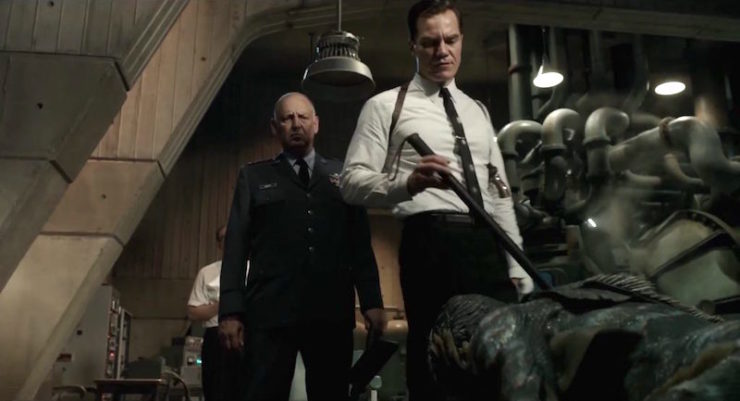
And then there is Elisa, who uses sign language as her primary form of connection to the world, while knowing that most of the people around her don’t see this as a legitimate form of communication. In asking Giles to help her rescue the Asset, she asks him to translate her signing into words, knowing that if he has to say what she is signing out loud, it will likely have a greater effect on him. What she tells him highlights this precise problem; she lets Giles know that the Asset has no concept of how humans typically communicate, and as a result, he does not find her lacking. He does not think her “incomplete.” Because the Asset has no biases about human communication, he does not think of Elisa as a disabled person. She is just the woman he loves, as she wants to be seen.
Elisa communicates in many ways that have nothing to do with ASL, and the film puts a sharp focus on those forms as well to highlight the complexity of communication. Elisa first bonds with the Asset by bringing him eggs, sharing a meal and therefore making it clear that she means to nourish him and be kind. She communicates by sharing music with him and with others. She and Giles have a fondness for musicals, and they dance together, mimicking their favorite stars and artists. When Elisa wishes that she could better indicate her affection for the Asset, she imagines that they are performing in one of those musical numbers in a black and white film. Art is a form of communication that Elisa understands quite well, and she employs it in her interactions with the people that she cares about most. Sex is also a form of communication, one that Elisa eventually reaches in furthering her relationship with her beau. In the absence of speech, Elisa has so many other methods of connecting and communicating, and this fluency enables her to connect with someone who will love her as she wants to be loved.
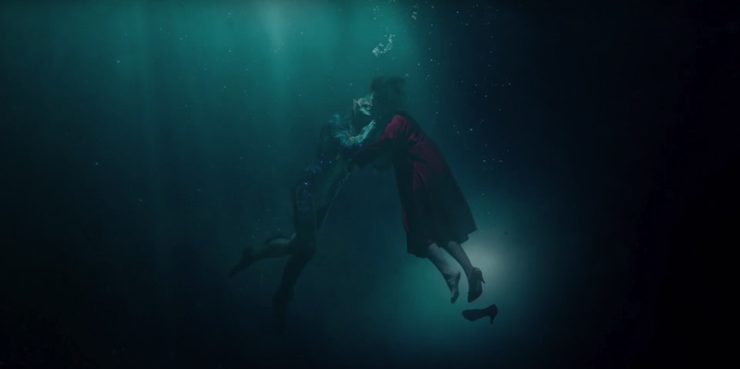
Which all leads to the Asset himself, and how his ability to communicate is what sets him apart from the Gill-man he was based on. Guillermo del Toro has admitted that The Shape of Water was largely inspired by his love for Creature from the Black Lagoon, a film he watched as a boy where he found himself in love with both the Creature and Kay Lawrence, the woman the Creature falls for. Del Toro apparently believed fervently that they should have ended up together, and wanted to create that happy ending for them both. But unlike the original film, which sees a monster simply taking what it wants when it sees Kay in the water, the Asset makes the choice to communicate first. He learns to sign what Elisa teaches him, he listens to the music she plays for him, he responds to her kindness with his own. He is not entitled like the villains around him, but he is also not thoughtless like his predecessor. He wants to be with Elisa because she wants to be with him.
The Shape of Water tells us that the only thing keeping us going, in a world full of fear and uncertainty, is our ability to communicate and connect with others. Across all differences, across all difficulties, across all imaginary lines. Some people have far greater barriers preventing them from connecting openly than others, but it is still the most worthwhile use of our time imaginable. And in this day and age, it is a gift we dare not waste.
Emmet Asher-Perrin wishes more people used dance as a primary form of communication. You can bug her on Twitter and Tumblr, and read more of her work here and elsewhere.










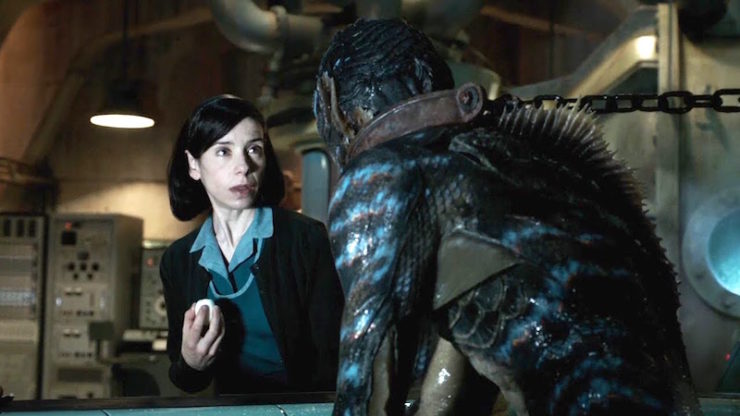
You have definitely stirred my interest in this one.
I imagine it’ll attract a lot of protests for casting a hearing actress as a Deaf character. Looks like a good film though.
@2: I believe the character is only mute, not a deaf-mute. She does listen and dance to music.